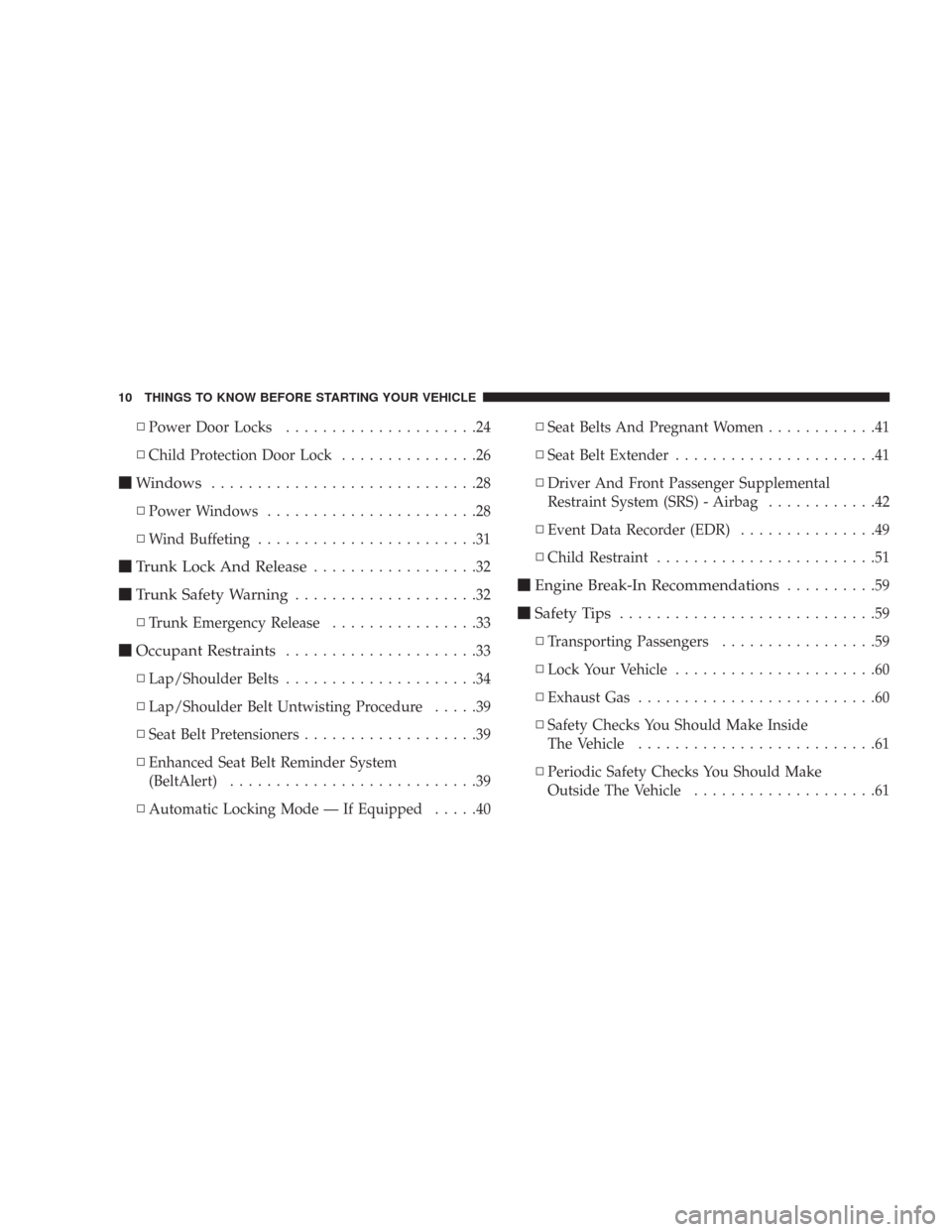Page 10 of 384

▫Power Door Locks.....................24
▫Child Protection Door Lock...............26
�Windows.............................28
▫Power Windows.......................28
▫Wind Buffeting........................31
�Trunk Lock And Release..................32
�Trunk Safety Warning....................32
▫Trunk Emergency Release................33
�Occupant Restraints.....................33
▫Lap/Shoulder Belts.....................34
▫Lap/Shoulder Belt Untwisting Procedure.....39
▫Seat Belt Pretensioners...................39
▫Enhanced Seat Belt Reminder System
(BeltAlert)...........................39
▫Automatic Locking Mode — If Equipped.....40▫Seat Belts And Pregnant Women............41
▫Seat Belt Extender......................41
▫Driver And Front Passenger Supplemental
Restraint System (SRS) - Airbag............42
▫Event Data Recorder (EDR)...............49
▫Child Restraint........................51
�Engine Break-In Recommendations..........59
�Safety Tips............................59
▫Transporting Passengers.................59
▫Lock Your Vehicle......................60
▫Exhaust Gas..........................60
▫Safety Checks You Should Make Inside
The Vehicle..........................61
▫Periodic Safety Checks You Should Make
Outside The Vehicle....................61
10 THINGS TO KNOW BEFORE STARTING YOUR VEHICLE
Page 59 of 384

ENGINE BREAK-IN RECOMMENDATIONS
A long break-in period is not required for the engine in
your new vehicle.
Drive moderately during the first 300 miles (500 km).
After the initial 60 miles (100 km), speeds up to 50 or 55
mph (80 or 90 km/h) are desirable.
While cruising, brief full-throttle acceleration, within the
limits of local traffic laws, contributes to a good break-in.
Wide-open throttle acceleration in low gear can be detri-
mental and should be avoided.
The engine oil installed in the engine at the factory is a
high quality energy conserving type lubricant. Oil
changes should be consistent with anticipated climate
conditions under which vehicle operations will occur.
The recommended viscosity and quality grades are
shown in Section 7 of this manual. NON-DETERGENT
OR STRAIGHT MINERAL OILS MUST NEVER BE
USED.A new engine may consume some oil during its first few
thousand miles (kilometers) of operation. This should be
considered as a normal part of the break-in and not
interpreted as an indication of difficulty.
SAFETY TIPS
Transporting Passengers
NEVER TRANSPORT PASSENGERS IN THE CARGO
AREA.
WARNING!
It is extremely dangerous to ride in a cargo area,
inside or outside of a vehicle. In a collision, people
riding in these areas are more likely to be seriously
injured or killed.
Do not allow people to ride in any area of your
vehicle that is not equipped with seats and seat belts.
Be sure everyone in your vehicle is in a seat and
using a seat belt properly.
THINGS TO KNOW BEFORE STARTING YOUR VEHICLE 59
2
Page 159 of 384

AM/FM Button (Radio Mode)
Press the button to select AM or FM Modes.
Setting the Tone, Balance, and Fade
Press the rotary TUNE control and BASS will display.
Turn the TUNE control to the right or left to increase or
decrease the Bass tones.
Press the rotary TUNE control a second time and MID
will display. Turn the TUNE control to the right or left to
increase or decrease the Mid Range tones.
Press the rotary TUNE control a third time and TREBLE
will display. Turn the TUNE control to the right or left to
increase or decrease the Treble tones.
Press the rotary TUNE control a fourth time and BAL will
display. Turn the TUNE control to the right or left to
adjust the sound level from the right or left side speakers.
Press the rotary TUNE control a fifth time and FADE will
display. Turn the TUNE control to the right or left to
adjust the sound level between the front and rear speak-
ers.Press the rotary TUNE control again to exit setting tone,
balance, and fade.
RND/PTY Button (Radio Mode)
Pressing this button once will turn on the PTY mode for
5 seconds. If no action is taken during the 5-second time
out, the PTY icon will turn off. Turning the tune knob
within 5 seconds will allow the program format type to
be selected. Many radio stations do not currently broad-
cast PTY information.
Turn the tune knob to select the following format types:
Program Type16 Digit-Character
Display
No program type or un-
definedNone
News News
Information Information
Sports Sports
Talk Talk
Rock Rock
Classic Rock Classic_Rock
Adult Hits Adult_Hits
UNDERSTANDING YOUR INSTRUMENT PANEL 159
4
Page 173 of 384

SATELLITE RADIO — IF EQUIPPED
Satellite radio uses direct satellite to receiver broadcast-
ing technology to provide clear digital sound, coast to
coast. The subscription service provider is Sirius™ Satel-
lite Radio. This service offers over 100 channels of music,
sports, news, entertainment, and programming for chil-
dren, directly from its satellites and broadcasting studios.
System Activation
NOTE:
Your vehicle’s radio must be on and in satellite
mode when the activation process takes place.
To activate your Sirius Satellite Radio service, call the
toll-free number 888-539-7474, or visit the Sirius web site
at www.sirius.com. Please have the following informa-
tion available when activating your system:
1. The Electronic Serial Number/Sirius Identification
Number (ESN/SID).
2. Credit card information.
3. Your Vehicle Identification Number.
Electronic Serial Number/Sirius Identification
Number (ESN/SID)
The Electronic Serial Number/Sirius Identification Num-
ber is needed to activate your Sirius Satellite Radio
system. To access the ESN/SID, refer to the following
steps:
Remote Control Location
UNDERSTANDING YOUR INSTRUMENT PANEL 173
4